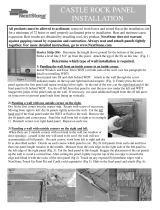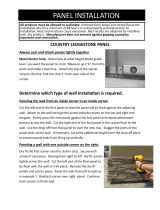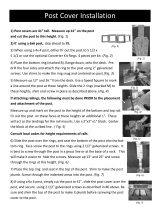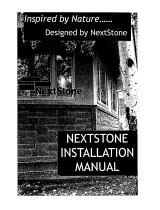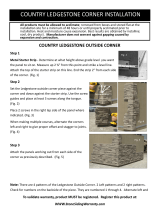
17
RANDOM ROCK OUTSIDE CORNER, Cont.
5.After curing, fill any gaps between the panel face and converter piece with NextStone grout. Fill from
the back side to insure a solid grout line is achieved (Fig. 3). Use putty knife along rock edges to achieve
a smooth surface. After it becomes tacky, use touch up kit to paint the exposed edges and grout (Fig. 4).
6.Attach the piece as if it were a full panel (Fig. 5).
1 - If terminating the run on the right side with other trim pieces, follow these instructions– For 2
facing Outside Corners follow Section 3 on previous page. Starting from the left, take a full panel and
attach the bottom tongue into the starter strip groove, lock in place, and slide the panel
left behind the accessory piece, see back. Using the screw guide points, screw through
the substrate and into a stud when practical, with a minimum of 6 screws per panel
and a screw no less than 1" from each end of the tongue as well as in the bottom right
corner of the tongue. Working left to right continue installing panels in the bottom
course making sure each panel is properly set in the starter strip. For the last panel in
the course, measure from the edge of the grout line to the accessory piece, add 1" If
sliding behind a trim piece, cut the last piece until the panel is locked in the starter
strip, then slide panel back to the left until the shiplap sides are joined. Check for
level.
2 - Install the remaining courses by beginning the course from the left with full
panels. The stagger is built in with the corner pieces. Slide the panel down over the
tongue of the first row. Install remaining panels in the course, end row as before,
and check for level. Align panels using the alignment mark at each side on the
tongue. Do not align panels using the top of the tongue. The remaining courses are
installed the same way. Stagger the NextStone butt joints so that no two courses
are aligned vertically unless separated by three courses. All exposed edges
should be painted and caulked behind trim pieces.
3 - Cut panels around fixtures and other wall protrusions (hose bibs, electrical
boxes, dryer vents, etc) to accommodate NextStone Mounting Blocks. See Install instructions, page 25 or
NextStone.com for details on how to cut panels and install the mounting blocks.
OPTIONAL ADHESIVE INSTALLATION
Step 1 - Lightly sand ridges on the back of the panel to remove any mold release agent that may have
adhered to the panel. The mold release agent will interfere with the adhesion of the panel.
Step 2 - Apply a ⅜" bead of adhesive along vertical ridges of the panel.
Step 3 - Remember to always use a quality that is compatible with polyurethane. In order for adhesives
to set properly, mechanical fasteners may be required to hold panels in place.
Figure 1
Figure 2
Figure 3
Figure 4 Figure 5




















